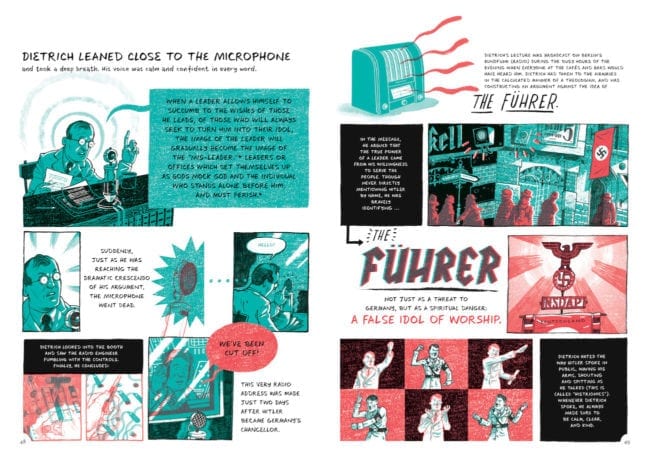It’s the time traveler’s dilemma: would you go back and kill Hitler? Think of your answer. Okay, now: what if you were living in Germany during Hitler’s rise to power, no time machine required? What then? And just one more: what if you were a man of God?
The Faithful Spy: Dietrich Bonhoeffer and the Plot to Kill Hitler is one man’s answer to these questions. Author John Hendrix tells Bonhoeffer’s story in a mix of text, illustrations, and small panels of sequential art; it’s a striking combination. The Faithful Spy is a blockbuster of a book, brimming with quotes, maps, fact boxes, and eye-popping symbolism. Some pages could be propaganda posters, only without patriotic slogans splashed across them.
Dietrich Bonhoeffer decided early to dedicate his life to God, and the first few chapters of the book show him already wrestling with complicated theological issues. Are “duty to God” and “duty to country” the same thing? Should the church be a “revolutionary force?” Is it possible to have a “good war”? After a journey to America, Bonhoeffer returns, revitalized, to Germany – just in time to witness his church’s complacency in the face of Hitler’s consolidation of power.
The book alternates between Bonhoeffer’s story and the prelude to World War II: part religious biography, part history textbook. There’s no shortage of pictorial bombast. Storm clouds on the horizon. Blood and broken glass. A train tumbling of its tracks. And Hitler as a giant wolf, devouring his enemies. (An image that, it occurred to me, Hitler probably would’ve thought was pretty awesome.) Hendrix drops in facts like “a popular storm trooper fight song was chillingly titled ‘When Jewish Blood Spurts From My Knife’”.
 In fact, the only real sense that The Faithful Spy is a book for young readers comes with Hendrix’s editorializing – like that word “chillingly”, above. After explaining Hitler’s plan to take over Germany and eradicate the Jewish people, Hendrix gives over a whole page to explain “These were horrid ideas.” Does he not trust his audience to see how horrific the Nazi regime was? Or is this just how we have to talk today when the fact that Nazis are bad seems distressingly up for debate once more? I’m not sure.
In fact, the only real sense that The Faithful Spy is a book for young readers comes with Hendrix’s editorializing – like that word “chillingly”, above. After explaining Hitler’s plan to take over Germany and eradicate the Jewish people, Hendrix gives over a whole page to explain “These were horrid ideas.” Does he not trust his audience to see how horrific the Nazi regime was? Or is this just how we have to talk today when the fact that Nazis are bad seems distressingly up for debate once more? I’m not sure.
For all its despair, The Faithful Spy contains punch-the-air moments of resistance. The following quote adorns a page featuring Bonhoeffer as David versus a monstrous Goliath: “Dietrich’s resolve to resist Hitler had swelled into a holy anger. Christians must see the Jews as their brothers, as ‘Children of the Covenant’. He believed an attack on Jewish people was an attack on all of God’s children. If the church, in this moment did” (and now the font increases in size and passion) “not exist to protect the other, it had no right to be called the church at all.”
And we haven’t even reached the assassination attempts! Bonhoeffer is forced to ask himself whether God would forgive the murder of a tyrant and comes to the conclusion that he must act. (As James 2:26 says, “faith without works is dead also”.) He joins a conspiracy to murder Hitler and now lives a life of deception and violence. The attempts on Hitler’s life, especially the infamous Operation Valkyrie, are thrillingly presented here despite the fact we know what happens. Hendrix’s knack of guiding his reader’s eye effortlessly around the page is particularly apparent in these sequences of ticking clocks, sweating brows, and missed opportunities.
 In the final chapters of The Faithful Spy, however, Bonhoeffer’s opportunities to act are stripped away. He has to find other, less dramatic ways to fight for God and country, and Hendrix uses these to show how small acts of kindness can be revolutionary, too. The book’s strongest quality may be that despite its many binary oppositions – good versus evil, Bonhoeffer versus Hitler, and even a two-toned color scheme of green versus red – it presents a fascinating life of moral questions not so easily answered.
In the final chapters of The Faithful Spy, however, Bonhoeffer’s opportunities to act are stripped away. He has to find other, less dramatic ways to fight for God and country, and Hendrix uses these to show how small acts of kindness can be revolutionary, too. The book’s strongest quality may be that despite its many binary oppositions – good versus evil, Bonhoeffer versus Hitler, and even a two-toned color scheme of green versus red – it presents a fascinating life of moral questions not so easily answered.







